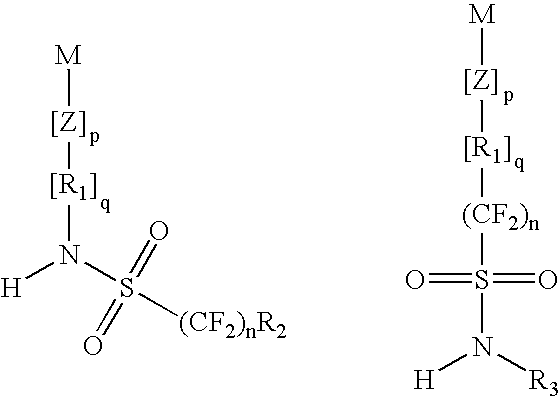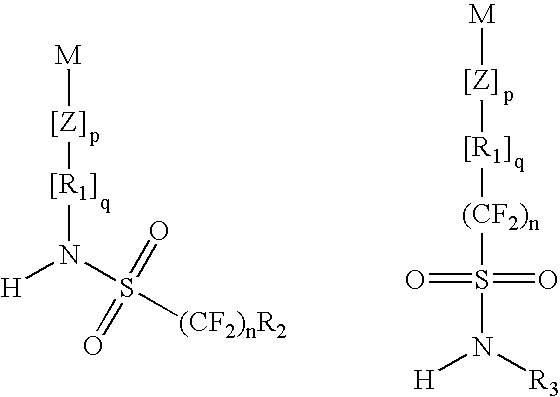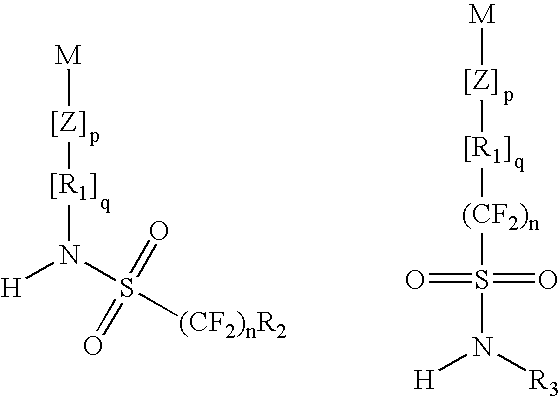Top coat material and use thereof in lithography processes
- Summary
- Abstract
- Description
- Claims
- Application Information
AI Technical Summary
Problems solved by technology
Method used
Image
Examples
example 1
Synthesis of poly(2-trifluoromethanesulfonylaminoethyl methacrylate)(poly(I))
[0028] A solution of 7.8 g (0.03 mol) of 2-trifluoromethanesulfonylaminoethyl methacrylate (I) and 0.061 g (0.0003 mol) dodecanethiol in 22.6 g of 2-butanone was first prepared. To this solution was added 0.148 g (0.0009 mol) of 2,2′-azobisisobutyronitrile (AIBN). The solution was deoxygenated by bubbling dry N2 for 0.5 hr and then allowed to reflux for 12 hr. The reaction mixture was cooled to room temperature and precipitated in 400 ml of hexanes with rigorous stirring. The resulting white solid was collected by filtration, washed with several portions of hexanes and dried under vacuum at 60° C. for 20 hr.
example 2
Synthesis of poly(I-co-XVIII)
[0029] A solution of 4.7 g (0.018 mol) of 2-trifluoromethanesulfonylaminoethyl methacrylate (I), 2.83 g (0.012 mol) hydroxyadamantyl methacrylate (XVIII) and 0.061 g (0.0003 mol) dodecanethiol in 22.6 g of 2-butanone was first prepared. To this solution was added 0.148 g (0.0009 mol) of AIBN. The solution was deoxygenated by bubbling dry N2 for 0.5 hr and then allowed to reflux for 12 hr. The reaction mixture was cooled to room temperature and precipitated in 400 ml of hexanes with rigorous stirring. The resulting white solid was collected by filtration, washed with several portions of hexanes and dried under vacuum at 60° C. for 20 hr.
example 3
Synthesis of poly(I-co-XVIII-co-XVI)
[0030] A solution of 5.22 g (0.02 mol) of 2-trifluoromethanesulfonylaminoethyl methacrylate (I), 3.78 g (0.016 mol) hydroxyadamantyl methacrylate (XVIII), 0.52 g (0.004 mol) 2-hydroxyethyl methacrylate (XVI), and 0.081 g (0.0004 mol) dodecanethiol in 22.6 g of 2-butanone was first prepared. To this solution was added 0.197 g (0.0012 mol) of AIBN. The solution was deoxygenated by bubbling dry N2 for 0.5 hr and then allowed to reflux for 12 hr. The reaction mixture was cooled to room temperature and precipitated in 400 ml of hexanes with rigorous stirring. The resulting white solid was collected by filtration, washed with several portions of hexanes and dried under vacuum at 60° C. for 20 hr.
PUM
 Login to View More
Login to View More Abstract
Description
Claims
Application Information
 Login to View More
Login to View More - R&D
- Intellectual Property
- Life Sciences
- Materials
- Tech Scout
- Unparalleled Data Quality
- Higher Quality Content
- 60% Fewer Hallucinations
Browse by: Latest US Patents, China's latest patents, Technical Efficacy Thesaurus, Application Domain, Technology Topic, Popular Technical Reports.
© 2025 PatSnap. All rights reserved.Legal|Privacy policy|Modern Slavery Act Transparency Statement|Sitemap|About US| Contact US: help@patsnap.com



